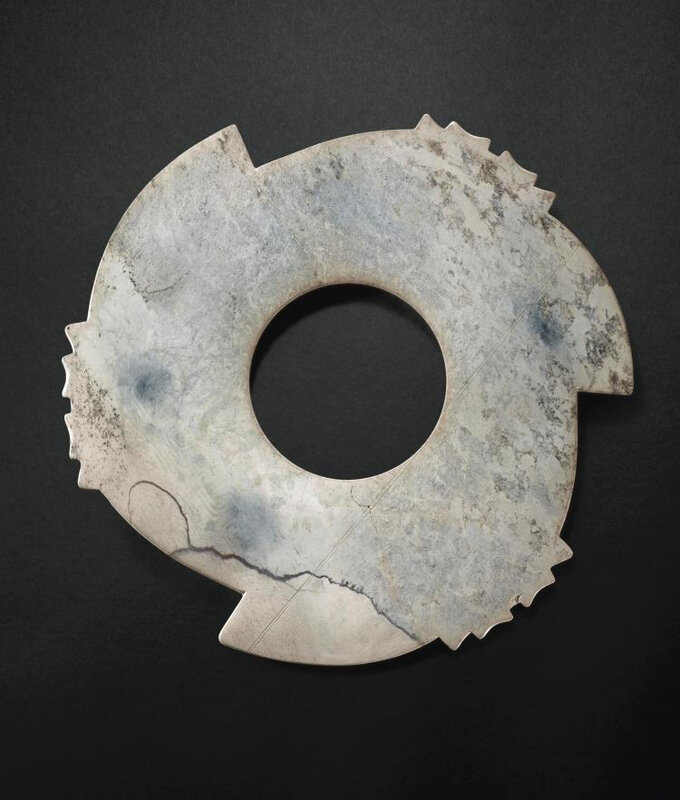Important Grand disque Archaïque Cranté en Jade, Xuanji, époque néolithique - Dynastie Shang, ca. 2000-1200 avant J.-C.
Lot 24. Important Grand disque Archaïque Cranté en Jade, Xuanji, époque néolithique - Dynastie Shang, ca. 2000-1200 avant J.-C.; Diam. 33 cm. Estimation 80,000 — 120,000 EUR. Lot Vendu 339,000 EUR. Courtesy Sotheby's 2015.
la pierre délicatement sculptée en forme d'un grand disque circulaire, les côtés doucement polis aux bords légèrement dénivelés autour d'une large ouverture centrale, les bords extérieurs ponctués de trois gros crans formant trois arcs, chaque arc flanqué de deux crans rectangulaires et une dent triangulaire, se terminant chacun en une dent acérée, une face soigneusement incisée de lignes horizontales et verticales s'entrecroisant, la pierre calficiée au poli exceptionnel à la teinte blanc-gris parcourue d'une veine noire et mouchetée de zones plus sombres, une face avec des traces d'un motif de leiwen, une fissure partant du centre au bord, D.W 34/115.
Exhibited: Arts de La Chine Ancienne, Musée de l’Orangerie, Paris, 1937, no. 89.
Literature: Georges Salles, Arts de La Chine Ancienne, Paris, 1937, cat. no. 89 and pl. XII.22.
Daisy Lion-Goldschmidt and Jean-Claude Moreau-Gobard, Chinese Art: Bronzes, Jade, Sculpture, Ceramics, reprint, 1980 (reprint), cat. no. 61.
Georges Salles, Arts de La Chine Ancienne, Paris, 1937. Image © Arrault et Cie, Tours, 1937.
Georges Salles, Arts de La Chine Ancienne, Paris, 1937, cat. no. 89 and pl. XII.22, Image © Arrault et Cie, Tours, 1937.
Note: Discs feature prominently among jade artifacts recovered from sites of the Neolithic period to Han dynasty. Among them, notched discs form a small but distinctive group. Defined by the deep notches that divide the circumference into segments, the earliest examples have been found in late neolithic sites on the east coast in Shandong province and in the west in Shaanxi province. For an overview on the development of notched discs, see Jessica Rawson, Chinese Jade from the Neolithic to the Qing, London, 1995, pp. 160-162.
On the present disc, one side shows a series of straight horizontal and vertical lines that have been incised with great precision. Similar incised lines also appear on a notched disc formerly in the K.C. Wang Collection, famoulsy reproduced in a line drawing in Wu Dacheng's Gu Yu tu kao, Shanghai, 1889, p. 50, left. In the accompanying text, Wu Dacheng identifies notched discs as xuanji based on a reference from a text from the Shu jing.
The present disc is unusually large and no other jade notched disc of this size seems to have been recorded. A much smaller disc excavated from Lizhuang, Teng Xian, Shandong, attributed to the Longshan culture of the neolithic period (ca. 2500-2000 BC) shows a closely related profile. Like the David-Weill disc, the excavated disc is carved from a softly polished matte grey jade stone, the notched outline further enhanced with small series of teeth, compare Zhongguo yuqi quanji, vol. 1 (Neolithic), Hebei, 1992, no. 42. Few other if smaller examples have been excavated, yet several more have survived in collections formed at the same time as the David-Weill Collection in the 1920s and 1930s. A disc formerly in the Eumorfopoulos Collection, London, and acquired by the British Museum in 1937, is carved of the same greyish white stone, see Soame Jenyns, Chinese Archaic Jades in the British Museum, London, 1951, pl. X. Compare also an example from the collection of HRH King Gustav VI Adolf of Sweden, published in Nils Palmgren, Selected Chinese Antiquities from the Collection of Gustav Adolf Crown Prince of Sweden, Stockholm, 1948, pl. 40.1.
Sotheby's. Trésors de la Chine ancienne de la collection David David-Weill, Paris, 16 Dec 2015

/https%3A%2F%2Fprofilepics.canalblog.com%2Fprofilepics%2F1%2F0%2F100183.jpg)
/https%3A%2F%2Fstorage.canalblog.com%2F03%2F02%2F119589%2F96711876_o.jpg)
/https%3A%2F%2Fstorage.canalblog.com%2F11%2F31%2F119589%2F94773502_o.jpg)
/https%3A%2F%2Fstorage.canalblog.com%2F20%2F83%2F119589%2F94772815_o.jpg)
/https%3A%2F%2Fstorage.canalblog.com%2F26%2F72%2F119589%2F75604929_o.jpg)
/https%3A%2F%2Fstorage.canalblog.com%2F59%2F60%2F119589%2F26458628_o.jpg)








/http%3A%2F%2Fstorage.canalblog.com%2F38%2F63%2F119589%2F94237744_o.jpg)
/http%3A%2F%2Fstorage.canalblog.com%2F45%2F82%2F119589%2F94237673_o.jpg)
/http%3A%2F%2Fstorage.canalblog.com%2F17%2F69%2F119589%2F122542330_o.jpg)
/http%3A%2F%2Fstorage.canalblog.com%2F04%2F65%2F119589%2F122541728_o.jpg)